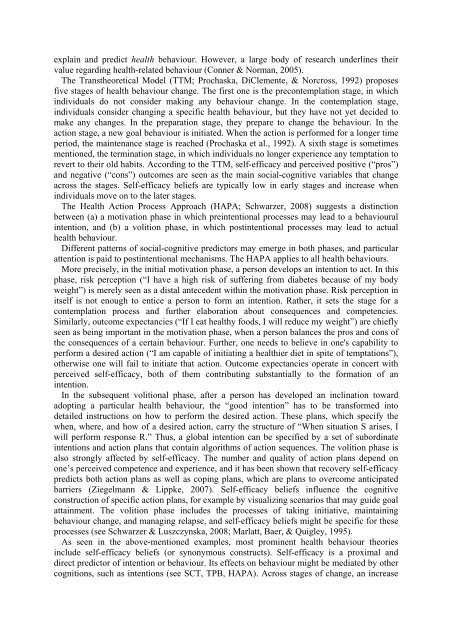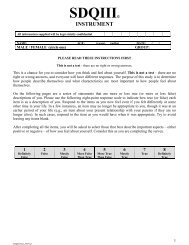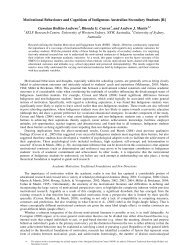Perceived Self-Efficacy in Health Behaviour Change The Construct of
Perceived Self-Efficacy in Health Behaviour Change The Construct of
Perceived Self-Efficacy in Health Behaviour Change The Construct of
You also want an ePaper? Increase the reach of your titles
YUMPU automatically turns print PDFs into web optimized ePapers that Google loves.
expla<strong>in</strong> and predict health behaviour. However, a large body <strong>of</strong> research underl<strong>in</strong>es their<br />
value regard<strong>in</strong>g health-related behaviour (Conner & Norman, 2005).<br />
<strong>The</strong> Transtheoretical Model (TTM; Prochaska, DiClemente, & Norcross, 1992) proposes<br />
five stages <strong>of</strong> health behaviour change. <strong>The</strong> first one is the precontemplation stage, <strong>in</strong> which<br />
<strong>in</strong>dividuals do not consider mak<strong>in</strong>g any behaviour change. In the contemplation stage,<br />
<strong>in</strong>dividuals consider chang<strong>in</strong>g a specific health behaviour, but they have not yet decided to<br />
make any changes. In the preparation stage, they prepare to change the behaviour. In the<br />
action stage, a new goal behaviour is <strong>in</strong>itiated. When the action is performed for a longer time<br />
period, the ma<strong>in</strong>tenance stage is reached (Prochaska et al., 1992). A sixth stage is sometimes<br />
mentioned, the term<strong>in</strong>ation stage, <strong>in</strong> which <strong>in</strong>dividuals no longer experience any temptation to<br />
revert to their old habits. Accord<strong>in</strong>g to the TTM, self-efficacy and perceived positive (“pros”)<br />
and negative (“cons”) outcomes are seen as the ma<strong>in</strong> social-cognitive variables that change<br />
across the stages. <strong>Self</strong>-efficacy beliefs are typically low <strong>in</strong> early stages and <strong>in</strong>crease when<br />
<strong>in</strong>dividuals move on to the later stages.<br />
<strong>The</strong> <strong>Health</strong> Action Process Approach (HAPA; Schwarzer, 2008) suggests a dist<strong>in</strong>ction<br />
between (a) a motivation phase <strong>in</strong> which pre<strong>in</strong>tentional processes may lead to a behavioural<br />
<strong>in</strong>tention, and (b) a volition phase, <strong>in</strong> which post<strong>in</strong>tentional processes may lead to actual<br />
health behaviour.<br />
Different patterns <strong>of</strong> social-cognitive predictors may emerge <strong>in</strong> both phases, and particular<br />
attention is paid to post<strong>in</strong>tentional mechanisms. <strong>The</strong> HAPA applies to all health behaviours.<br />
More precisely, <strong>in</strong> the <strong>in</strong>itial motivation phase, a person develops an <strong>in</strong>tention to act. In this<br />
phase, risk perception (“I have a high risk <strong>of</strong> suffer<strong>in</strong>g from diabetes because <strong>of</strong> my body<br />
weight”) is merely seen as a distal antecedent with<strong>in</strong> the motivation phase. Risk perception <strong>in</strong><br />
itself is not enough to entice a person to form an <strong>in</strong>tention. Rather, it sets the stage for a<br />
contemplation process and further elaboration about consequences and competencies.<br />
Similarly, outcome expectancies (“If I eat healthy foods, I will reduce my weight”) are chiefly<br />
seen as be<strong>in</strong>g important <strong>in</strong> the motivation phase, when a person balances the pros and cons <strong>of</strong><br />
the consequences <strong>of</strong> a certa<strong>in</strong> behaviour. Further, one needs to believe <strong>in</strong> one's capability to<br />
perform a desired action (“I am capable <strong>of</strong> <strong>in</strong>itiat<strong>in</strong>g a healthier diet <strong>in</strong> spite <strong>of</strong> temptations”),<br />
otherwise one will fail to <strong>in</strong>itiate that action. Outcome expectancies operate <strong>in</strong> concert with<br />
perceived self-efficacy, both <strong>of</strong> them contribut<strong>in</strong>g substantially to the formation <strong>of</strong> an<br />
<strong>in</strong>tention.<br />
In the subsequent volitional phase, after a person has developed an <strong>in</strong>cl<strong>in</strong>ation toward<br />
adopt<strong>in</strong>g a particular health behaviour, the “good <strong>in</strong>tention” has to be transformed <strong>in</strong>to<br />
detailed <strong>in</strong>structions on how to perform the desired action. <strong>The</strong>se plans, which specify the<br />
when, where, and how <strong>of</strong> a desired action, carry the structure <strong>of</strong> “When situation S arises, I<br />
will perform response R.” Thus, a global <strong>in</strong>tention can be specified by a set <strong>of</strong> subord<strong>in</strong>ate<br />
<strong>in</strong>tentions and action plans that conta<strong>in</strong> algorithms <strong>of</strong> action sequences. <strong>The</strong> volition phase is<br />
also strongly affected by self-efficacy. <strong>The</strong> number and quality <strong>of</strong> action plans depend on<br />
one’s perceived competence and experience, and it has been shown that recovery self-efficacy<br />
predicts both action plans as well as cop<strong>in</strong>g plans, which are plans to overcome anticipated<br />
barriers (Ziegelmann & Lippke, 2007). <strong>Self</strong>-efficacy beliefs <strong>in</strong>fluence the cognitive<br />
construction <strong>of</strong> specific action plans, for example by visualiz<strong>in</strong>g scenarios that may guide goal<br />
atta<strong>in</strong>ment. <strong>The</strong> volition phase <strong>in</strong>cludes the processes <strong>of</strong> tak<strong>in</strong>g <strong>in</strong>itiative, ma<strong>in</strong>ta<strong>in</strong><strong>in</strong>g<br />
behaviour change, and manag<strong>in</strong>g relapse, and self-efficacy beliefs might be specific for these<br />
processes (see Schwarzer & Luszczynska, 2008; Marlatt, Baer, & Quigley, 1995).<br />
As seen <strong>in</strong> the above-mentioned examples, most prom<strong>in</strong>ent health behaviour theories<br />
<strong>in</strong>clude self-efficacy beliefs (or synonymous constructs). <strong>Self</strong>-efficacy is a proximal and<br />
direct predictor <strong>of</strong> <strong>in</strong>tention or behaviour. Its effects on behaviour might be mediated by other<br />
cognitions, such as <strong>in</strong>tentions (see SCT, TPB, HAPA). Across stages <strong>of</strong> change, an <strong>in</strong>crease





